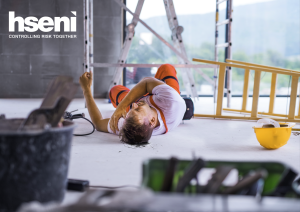Falls from height claim four lives in NI in four weeks
Date published:
HSENI have announced that there have been 4 fatalities as a result of falls from height since the beginning of January 2020.

Falls from height remain one of the biggest causes of death, disability and injury in construction and are of great concern to HSENI.
These tragic cases underscore the dangers of falling inside a building under construction and the critical importance of providing internal fall protection when working at heights.
Many contractors have got to grips with external fall protection by using perimeter scaffolding and Mobile Elevating Work Platforms (MEWPs) etc. On the other hand some don't appreciate the need for internal fall protection when carrying out work at height, such as:
- stripping, dismantling and refurbishing roofs
- installing joists or roof trusses
- dismantling or installing roof sheets and side panelling on commercial buildings
- fixing battens or tile supports and roof tiles
- installing concrete floor slabs or stairs
- working near or over fragile surfaces
- working adjacent to voids in the roof and floor
Principal Designers must work with other designers at the pre-construction stage to eliminate foreseeable health and safety risks from internal falls, and where that is not possible, take steps to reduce or control those risks. For example it may be possible for designers to utilise elements of the final structure during the construction phase, e.g. by installing the permanent stairs early in the build to reduce the need for scaffolding or temporary access.
Hierarchy of fall protection measures
There is a hierarchy of fall protection measures to be taken when planning or carrying out work at height, including work internal to the building:
- Avoid work at height
- Use work equipment or other measures to prevent falls
- Use work equipment or other measures to minimise the distances and consequences of a fall should one occur
This hierarchy has to be followed systematically and only when one level is not reasonably practicable may the next level down be considered.
Internal fall protection
Recognised safe internal fall protection includes:
- proprietary decking systems
- birdcage scaffold
- safety trellies (extendable aluminium trellis)
- boarding out the inside of the roof using timber
- safety nets - so long as there is adequate clearance below and anchorage points which have been accessed by a competent person prior to the nets being installed
- inserting air bags / bean bags as soft landing systems
- harnesses which should be the last option considered and only used by workers who have been trained in their use (you need to consider the following as part of the risk assessment - strength and location of available anchor points, type / length of lanyard, suspension height and obstacles and how you will rescue someone who is suspended)
It is often necessary to create internal voids in buildings under construction or find existing ones in buildings being refurbished. Planning ahead to anticipate when these voids will constitute a risk to workers is essential. Key things to consider include:
- use mesh guards or covers which are permanently fixed into concrete floors - these provide protection to all workers throughout the job
- protect voids from underneath - using fixed scaffold
- where coverings on the floor these must be robust, securely fixed and signed
- if you carry out short duration works around the void, provide alternative protection, for example, scaffold underneath
Fragile materials
Falls through fragile materials are a particular problem in both the roof construction and building maintenance sectors. If possible, arrange the work to avoid working or passing near fragile material. If this is unavoidable, you should identify all fragile materials and put safety precautions in place.
Some fragile roof materials may give a false sense of security to those who are working on them or passing by them. They give the impression they can bear a person's weight, but they might not carry a concentrated load such as the heel of someone walking or a person stumbling and falling.
It is still a common but fatal belief that it is safe to walk along the line of roof bolts above a purlin but this is like walking a tightrope, where one false step or loss of balance can lead to disaster.
Plan ahead
Planning is vital before the work begins, so that it can be carried out safely, efficiently and without undue delay. The client must make sure that the individual or company is competent to do the work whether this is carrying out the construction work or installing the safety measures.
When developing the construction phase health and safety plan the principal contractor should include the safety measures required where there is work at height.
Where sub-contractors are involved, arrangements for their workforce working at height should be clearly documented as part of an agreed method statement following on from an adequate risk assessment.
The Health and Safety Executive (GB) has produced a guidance document - 'HSG 33 - Health and Safety in Roof Work' which can be downloaded free of charge at the following link:
HSENI strongly recommends you obtain a copy of this guidance document as it illustrates good practice and how to achieve compliance with the law.
Falls from height remain one of the most common causes of work-related injuries in this country and the risks associated with working at height are well known. Work at height will be a standing item on all construction inspections where relevant.
The means to ensure workers are safe when working at height are well documented and easily available and we urge the industry to act now to prevent further deaths and serious injuries.